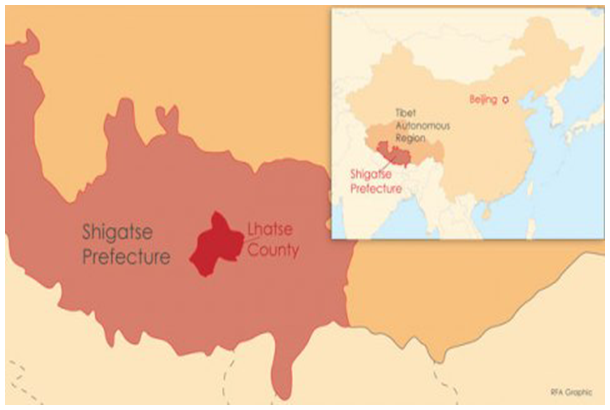Locals hit by China’s efforts to boost tourist numbers in Tibet
 Tibetans from Lhatse County in southwest Tibet have been forced off their land to accommodate the growing tourism industry in occupied Tibet. According to local sources, the land adjoining Lhatse and Dingri counties is being turned into an airport. This would be the second airport for nearby Shigatse City and the sixth in the Tibetan Autonomous Region (TAR).
Tibetans from Lhatse County in southwest Tibet have been forced off their land to accommodate the growing tourism industry in occupied Tibet. According to local sources, the land adjoining Lhatse and Dingri counties is being turned into an airport. This would be the second airport for nearby Shigatse City and the sixth in the Tibetan Autonomous Region (TAR).
In an interview on 23 March 2018, Chairman of the TAR Che Dalha spoke of the government’s efforts to build new airports and expand existing ones to boost tourism in Tibet. Chinese authorities in Tibet have also offered incentives to attract tourists such as discounted hotels and air tickets.
The results of these policies were highlighted in a report by China’s state-run media outlet Xinhua, which stated that the TAR received nearly 40,000 foreign tourists from January to April 2018. This is a 50.5% increase on the previous year. Meanwhile Tibet received nearly 2.7 million domestic tourists, again an increase compared to 2017.
The Chinese regional tourism development committee has boasted of the tourism revenue generated over this period. It estimates the region took in 26.7 million US dollars.
NEGATIVE EFFECTS
This rapid development contrasts with the negative effects experienced by the local Tibetan population. Sources confirmed to Tibet Watch that huge chunks of farmland, bordering Lhatse and Dingri counties, have been confiscated as part of the development of tourism infrastructure. Due to the tense political situation, photos of the land have been impossible to obtain.
Information on the land seizures has been further restricted by strict surveillance on communications, along with a notice given to local Tibetans warning them against sharing any news. One local source has had her number listed by local authorities, allowing her communications to be traced or put under surveillance. Meanwhile, another source’s WeChat account has been closed from a group that maintains communications with exiled Tibetans in India.
Many of the areas of land seized were farmlands, integral to the livelihoods of locals. Nevertheless, those affected have reportedly been given little in the way of compensation.
Confiscations of land are commonplace in Tibet and have also taken place in the name of developing economic zones or mining. A similar land grab took place in Nyimo County, central Tibet, earlier this year.
Further information on the growth of the tourism industry in Tibet, and the adverse effects it has had on the lives of Tibetans and on Tibetan culture, can be found in Tibet Watch’s report ‘Culture Clash: Tourism in Tibet’ .
Information supplied by http://www.freetibet.org


comment 0